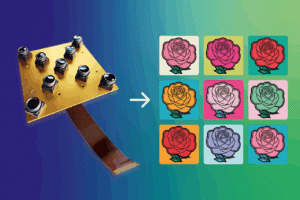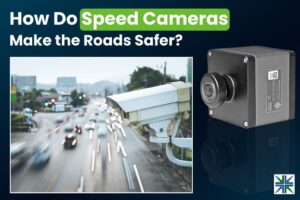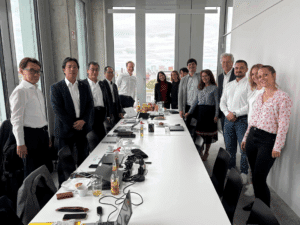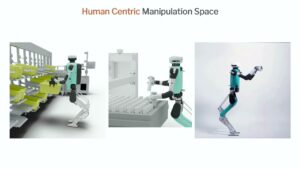Cameras and Sensors for Embedded Vision
WHILE ANALOG CAMERAS ARE STILL USED IN MANY VISION SYSTEMS, THIS SECTION FOCUSES ON DIGITAL IMAGE SENSORS
While analog cameras are still used in many vision systems, this section focuses on digital image sensors—usually either a CCD or CMOS sensor array that operates with visible light. However, this definition shouldn’t constrain the technology analysis, since many vision systems can also sense other types of energy (IR, sonar, etc.).
The camera housing has become the entire chassis for a vision system, leading to the emergence of “smart cameras” with all of the electronics integrated. By most definitions, a smart camera supports computer vision, since the camera is capable of extracting application-specific information. However, as both wired and wireless networks get faster and cheaper, there still may be reasons to transmit pixel data to a central location for storage or extra processing.
A classic example is cloud computing using the camera on a smartphone. The smartphone could be considered a “smart camera” as well, but sending data to a cloud-based computer may reduce the processing performance required on the mobile device, lowering cost, power, weight, etc. For a dedicated smart camera, some vendors have created chips that integrate all of the required features.
Cameras
Until recent times, many people would imagine a camera for computer vision as the outdoor security camera shown in this picture. There are countless vendors supplying these products, and many more supplying indoor cameras for industrial applications. Don’t forget about simple USB cameras for PCs. And don’t overlook the billion or so cameras embedded in the mobile phones of the world. These cameras’ speed and quality have risen dramatically—supporting 10+ mega-pixel sensors with sophisticated image processing hardware.
Consider, too, another important factor for cameras—the rapid adoption of 3D imaging using stereo optics, time-of-flight and structured light technologies. Trendsetting cell phones now even offer this technology, as do latest-generation game consoles. Look again at the picture of the outdoor camera and consider how much change is about to happen to computer vision markets as new camera technologies becomes pervasive.
Sensors
Charge-coupled device (CCD) sensors have some advantages over CMOS image sensors, mainly because the electronic shutter of CCDs traditionally offers better image quality with higher dynamic range and resolution. However, CMOS sensors now account for more 90% of the market, heavily influenced by camera phones and driven by the technology’s lower cost, better integration and speed.

Vision Components Presents VC MIPI Multiview Cam: MIPI CSI-2-based Camera for Light Field Measurement and Multispectral Imaging
VC MIPI Multiview Cam is a new OEM module for light field measurements, multiview and multispectral imaging from Vision Components. It can be connected to common processor boards via a single MIPI CSI-2 interface. Ettlingen, October 09, 2025. Vision Components is expanding its product range with the VC MIPI Multiview Cam, a camera array with

How Do Speed Cameras Make the Roads Safer?
This blog post was originally published at e-con Systems’ website. It is reprinted here with the permission of e-con Systems. Speed cameras play a crucial role in promoting safer roads. They can detect, capture, and record instances of speeding. Get insights into how these cameras work and their major road safety use cases. Managing road

“SKAIVISION: Transforming Automotive Dealerships with Computer Vision,” a Presentation from SKAIVISION
Jason Fayling, Co-founder and Chief Technology Officer of SKAIVISION, presents the “SKAIVISION: Transforming Automotive Dealerships with Computer Vision” tutorial at the May 2025 Embedded Vision Summit. Imagine a busy car dealership: customers arrive and wait to talk to sales or service people; vehicles enter and depart; safety checks need to… “SKAIVISION: Transforming Automotive Dealerships with

STMicroelectronics and Tobii Enter Mass Production of Breakthrough Interior Sensing Technology
Starting mass production of an advanced interior sensing system for a premium European carmaker for enhanced driver and passenger monitoring Cost-effective single-camera solution combines Tobii’s interior-sensing technology and ST’s imaging sensors to deliver wide-angle, high-quality imaging in daytime and nighttime environments Stockholm, Sweden; Geneva, Switzerland – October 2, 2025 — Tobii, the global leader in

Edge AI Hangs on Power: Can Chipmakers Meet Up?
Power semiconductors will define how well and how quickly the global economy adopts Edge AI and benefit from its promises. That’s why the race is stiffening among chipmakers to offer the most innovative power management components and systems. Who is winning? What’s at stake: The stakes for power semiconductor makers in the Edge AI market

FRAMOS and Restar Corporation Establish Joint Venture “RESTAR FRAMOS Technologies” (Formerly ViMOS Technologies) to Strengthen Distribution of SONY Image Sensors and Displays
Munich, Bavaria, Germany – October 1st, 2025 – FRAMOS GmbH today announced a strategic realignment with long-term partner Restar Corporation: the creation of RESTAR FRAMOS Technologies (formerly ViMOS Technologies), a joint venture that will take over SONY image sensor and display distribution across Europe, the Middle East, and North America, effective October 1st, 2025. By

What Is Image Denoising and What Are Its Methods?
This blog post was originally published at e-con Systems’ website. It is reprinted here with the permission of e-con Systems. A camera with effective denoising capabilities is essential for ensuring reliable object detection, classification, and measurement, particularly in embedded vision applications. To understand the various types of image noise and the different methods for reducing

“Developing a GStreamer-based Custom Camera System for Long-range Biometric Data Collection,” a Presentation from Oak Ridge National Laboratory
Gavin Jager, Researcher and Lab Space Manager at Oak Ridge National Laboratory, presents the “Developing a GStreamer-based Custom Camera System for Long-range Biometric Data Collection” tutorial at the May 2025 Embedded Vision Summit. In this presentation, Jager describes Oak Ridge National Laboratory’s work developing software for a custom camera system… “Developing a GStreamer-based Custom Camera

“Sensors and Compute Needs and Challenges for Humanoid Robots,” a Presentation from Agility Robotics
Vlad Branzoi, Perception Sensors Team Lead at Agility Robotics, presents the “Sensors and Compute Needs and Challenges for Humanoid Robots” tutorial at the September 2025 Edge AI and Vision Innovation Forum.

“Scaling Artificial Intelligence and Computer Vision for Conservation,” a Presentation from The Nature Conservancy
Matt Merrifield, Chief Technology Officer at The Nature Conservancy, presents the “Scaling Artificial Intelligence and Computer Vision for Conservation” tutorial at the May 2025 Embedded Vision Summit. In this presentation, Merrifield explains how the world’s largest environmental nonprofit is spearheading projects to scale the use of edge AI and vision… “Scaling Artificial Intelligence and Computer

